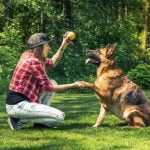Training a dog is an essential aspect of pet ownership, allowing for better communication and understanding between the dog and its owner. Whether you have a new puppy or an older dog, training can be a beneficial experience for both parties involved. In this article, we will explore the age at which dogs can be trained, as well as the benefits that come with it.
Training a dog not only teaches them basic commands but also helps in shaping their behavior and social skills. When a dog is well-trained, it becomes easier to manage them in various situations and environments. This training also establishes boundaries and rules that create a sense of safety for the dog within their surroundings. Additionally, training provides mental stimulation for the dogs, preventing boredom and potentially problematic behaviors.
Apart from improving behavior and enhancing communication, training offers numerous benefits. It strengthens the bond between the dog and its owner by creating trust and confidence. It also promotes healthy physical activity, as many training techniques involve exercise components like agility or obedience drills. Furthermore, training sessions provide an opportunity for dogs to use their brains and problem-solving abilities, keeping them mentally sharp.
In the next sections of this article, we will delve into more specific aspects related to dog training at different ages and stages of development. From early socialization during puppyhood to accommodation of breed characteristics and overcoming challenges encountered during training at various ages, we will explore it all in order to equip you with valuable knowledge on what age your furry companion can start their learning journey. So let’s jump right in.
Early Socialization and Basic Training (Puppyhood)
Early Socialization and Basic Training (Puppyhood):
During the early stages of a dog’s life, particularly in puppyhood, socialization and basic training are crucial for their development and overall behavior. This period, known as the critical period for socialization, is when puppies are most receptive to learning and adapting to new experiences. It is important for dog owners to start early in introducing their puppies to various people, animals, environments, and situations to ensure they grow up to be well-adjusted and confident adult dogs.
One of the key aspects of early socialization is exposing puppies to different stimuli in a positive and controlled manner. This can include meeting other vaccinated dogs and friendly people of different ages, genders, and appearances. By gradually introducing these experiences during this stage, puppies can develop good manners, proper behavior around others, and reduce the likelihood of developing fear or aggression towards unfamiliar things later in life.
In addition to socialization, basic training should also begin during puppyhood. Puppies have an innate curiosity and eagerness to learn, making it an ideal time to start teaching them basic commands such as sit, stay, come, lie down, or walking on a leash properly. These commands form the foundation for more advanced training later on. Using positive reinforcement techniques such as treats or praise helps reinforce desired behaviors and encourages puppies to continue learning.
– Key activities during early socialization:
- Introduce puppy to different environments.
- Expose them to various stimuli in a controlled way.
- Encourage positive interactions with people and animals.
– Basic training commands:
- Sit.
- Stay.
- Come.
- Lie down.
- Walking on a leash properly.
By focusing on early socialization and basic training during puppyhood, dog owners can set their furry friends up for success in their future training endeavors. Furthermore, establishing a solid foundation during this critical period helps promote optimal behavior throughout their lives. As puppies grow and transition through different developmental stages, it is important for dog owners to continue adapting their training techniques and strategies to suit the needs of their growing dogs.
Developmental Stages and Training
Understanding a dog’s developmental stages is crucial in determining the most effective training methods. Dogs go through different stages of development, each with its own challenges and opportunities for learning. By tailoring the training techniques to these stages, dog owners can ensure that their furry companions receive appropriate training at every age.
Adolescence
Adolescence is a critical stage in a dog’s life, typically occurring between 6 months to 2 years of age. During this period, dogs go through hormonal changes and physical growth, which can lead to behavioral challenges. They may become more independent, testing boundaries and exhibiting signs of rebellion. This stage is often characterized by increased energy levels and a need for mental stimulation.
To effectively train adolescent dogs, it is important to provide consistent boundaries and reinforcement. Positive reinforcement techniques, such as using treats or praise, can be highly effective during this stage. Engaging in interactive activities like agility training or puzzle toys can also help channel their energy into productive outlets.
Adulthood
As dogs transition into adulthood (around 2 years old), they start to settle into their full personalities. At this stage, they have more self-control and are capable of sustaining attention for longer periods. However, adult dogs may still exhibit certain behaviors that require further training or modification.
Adult dogs benefit from continued obedience training to reinforce commands already learned during their earlier stages. Mental stimulation remains important in preventing boredom and destructive behavior. Advanced training activities like scent work or advanced obedience exercises can help challenge their cognitive abilities while strengthening the bond between owner and dog.
Socialization Throughout Life
While socialization is often associated with puppyhood, it is an ongoing process that should continue throughout a dog’s life. Regular exposure to new people, animals, and environments helps prevent fearfulness or aggression towards unfamiliar stimuli.
During all stages of a dog’s life, it is important to continue exposing them to positive and controlled social situations. Doggy daycare, group walks, or obedience classes can provide opportunities for dogs to interact with others in a safe and controlled environment. By continuing to prioritize socialization throughout their lives, owners can help ensure that their dogs remain well-adjusted and confident in various settings.
Understanding the different developmental stages of a dog’s life is essential for effective training. Each stage presents unique challenges and opportunities that require customized training techniques. With proper training tailored to each stage, dog owners can set their furry friends up for success at every age.
Learning Capacities of Different Dog Breeds
Different dog breeds have varying learning capacities, which can significantly impact the training process. It is important for dog owners and trainers to understand how breed characteristics influence a dog’s ability to learn and respond to commands. By recognizing these differences, trainers can tailor their training techniques and adjust their expectations accordingly.
One key factor in determining a dog’s learning capacity is their breed instincts. Certain breeds have been selectively bred for specific purposes, such as herding, hunting, or guarding. These instincts can affect how quickly a dog learns certain commands or behaviors.
For example, herding dogs like Border Collies are known for their high levels of intelligence and trainability due to their centuries-old breeding for herding livestock. On the other hand, some breeds may be more stubborn or independent-minded, making it more challenging for them to grasp certain concepts during training.
Additionally, different breeds may excel in particular areas of training over others. For example, some breeds are known for their exceptional scenting abilities and might thrive in scent detection or search-and-rescue training. Similarly, breeds with strong retrieving instincts might excel in activities such as agility or obedience trials that require precise timing and quick response. Understanding these breed-specific strengths and tendencies can help trainers choose appropriate training activities that cater to a dog’s natural abilities.
In determining the optimal age for training different breeds, it is essential to consider breed-specific developmental stages. Some dogs reach maturity faster than others and may be ready to start more advanced training at an earlier age. For instance, larger breeds generally have longer developmental periods compared to smaller ones. Trainers should consider the physical capabilities of each breed at various stages of development when designing training programs.
Overall, recognizing the learning capacities of different dog breeds is crucial for effective and efficient training. By understanding how breed influences learning styles and capabilities, trainers can tailor their approach to match the individual needs of each dog. This not only enhances the success rate of training but also strengthens the bond between dog and owner by capitalizing on the unique qualities of different breeds.
Physical and Cognitive Development
The impact of physical development on training
Physical development plays a significant role in a dog’s ability to be trained effectively. Just like humans, dogs go through different stages of physical development as they age. It is important for dog owners to understand these stages and how they can affect the training process.
During the early stages of development, such as puppyhood, dogs are still growing and their bodies are developing rapidly. They may not have full control over their muscles or coordination, which can impact their ability to perform certain tasks or follow instructions.
It is crucial for dog owners to be patient and understanding during this period and avoid pushing their puppies too hard. Training sessions should be kept short and simple, focusing on basic commands that the puppy can grasp easily.
As dogs continue to grow, their physical abilities also improve. For example, during adolescence, dogs experience a growth spurt where they become taller and stronger. This stage is often accompanied by an increase in energy levels and excitability. Dog owners should take advantage of this burst of energy and engage in more physically demanding activities during training sessions, such as agility courses or playing fetch.
How cognitive abilities affect learning
Alongside physical development, cognitive abilities also play a crucial role in a dog’s capacity to learn and be trained effectively. Just like humans, dogs have varying levels of intelligence and problem-solving skills that can influence how quickly they pick up new commands or behaviors.
It is important for dog owners to recognize their individual dog’s cognitive strengths and weaknesses during the training process. Some dogs may have a natural aptitude for learning and may quickly grasp new commands with minimal repetition, while others may require more time and patience.
To optimize the training process based on cognitive abilities:
- Use positive reinforcement techniques: Dogs respond well to rewards-based training methods that praise desired behaviors with treats or affection. This helps reinforce positive associations with specific commands or actions.
- Break down complex tasks into smaller steps: For dogs that may struggle with more complicated commands, breaking them down into smaller, manageable steps can make the learning process less overwhelming and more achievable.
- Be consistent and repetitive: Consistency is key to helping dogs understand what is expected of them. Repeating commands and training sessions regularly helps reinforce learning and follow noopener”>develop muscle memory.
By understanding the impact of physical development and cognitive abilities on training, dog owners can tailor their approaches and techniques accordingly to ensure effective and positive outcomes during the training process.
Individual Factors
When it comes to training a dog, individual factors play a crucial role in determining the success and effectiveness of the training process. Two significant individual factors that heavily influence a dog’s ability to learn and respond to training are temperament and previous experiences.
Temperament plays a vital role in training success as it determines a dog’s natural tendencies towards behavior and learning. Some dogs may have a more eager-to-please temperament, making them quick learners and easily motivated by rewards. On the other hand, some dogs may be more independent or stubborn, requiring different training techniques that cater to their unique personality.
Previous experiences also play a crucial role in a dog’s ability to be trained. Dogs that have had positive experiences with training or socializing from an early age are generally more receptive to new commands and behavioral changes. However, dogs with negative experiences or trauma may require more time, patience, and specialized training methods to overcome their fears and anxieties.
To address these individual factors during training sessions, it is essential for dog owners or trainers to take a personalized approach based on each dog’s temperament and previous experiences. By understanding a dog’s unique personality traits and adapting the training methods accordingly, owners can create an environment that fosters positive learning experiences.
Moreover, using positive reinforcement techniques such as treats, praise, toys, or clicker training can help motivate dogs during the training process regardless of their individual factors. Reward-based training not only establishes trust between the owner and the dog but also encourages dogs to repeat desired behaviors willingly.
Understanding how individual factors influence the training process enables owners to tailor their approach to fit their dog’s specific needs. By doing so, they can build effective communication channels with their furry companion, enhance their bond, and ensure successful training outcomes.
| Individual Factors | Implications |
|---|---|
| Temperament | Determines a dog’s natural tendencies towards behavior and learning. |
| Previous Experiences | Influences a dog’s receptiveness to training based on positive or negative experiences. |
Age-Appropriate Training Activities
Training activities for dogs should take into consideration their age and developmental stage. It is important to provide them with appropriate exercises that will help develop their skills and ensure successful training. Different age groups have different needs and abilities, and adjusting the training intensity based on these factors can greatly contribute to the effectiveness of the training process.
For puppies in their early socialization and basic training stage, it is crucial to focus on activities that promote socialization and obedience. This includes exposing them to different people, environments, and other animals in a positive and controlled manner. Basic commands such as sit, stay, come, and leave it can also be introduced at this stage. These commands serve as foundation behaviors that will be built upon as the dog progresses in its training.
Adolescent dogs require more advanced exercises to challenge their growing abilities. Activities such as agility courses or trick training can provide mental stimulation while enhancing their coordination and focus. It is also important to continue reinforcing basic obedience commands during this stage to maintain good behavior.
Adult dogs benefit from continued practice of previously learned commands, but they can also be challenged with more complex tasks like scent detection or search and rescue training. Engaging in interactive games such as puzzle toys or hide-and-seek can keep their minds sharp while providing opportunities for bonding between the dog and its owner.
Adjusting the intensity of training based on a dog’s age is crucial to avoid overwhelming or frustrating them. Young puppies have short attention spans, so training sessions should be kept short but frequent throughout the day. As they grow older, sessions can gradually become longer with increased difficulty levels.
Overcoming Training Challenges at Different Ages
Training a dog can be a rewarding and fulfilling experience, but it is not without its challenges. Each stage of a dog’s development comes with its own set of obstacles that owners must navigate to ensure successful training. Understanding these challenges and developing strategies to overcome them is crucial for effective training at different ages.
One common challenge that many owners face during training is the distractibility of young puppies. Puppies have short attention spans and can easily become overwhelmed or lose focus during training sessions. To overcome this challenge, it is important to keep training sessions short and engaging.
Break up tasks into smaller steps and reward the puppy frequently for good behavior to help maintain their focus. Additionally, find a quiet and familiar environment for training that minimizes distractions and allows the puppy to fully concentrate on learning.
Another challenge that arises during adolescence is the onset of rebellious behaviors such as testing boundaries, ignoring commands, or exhibiting increased stubbornness. This stage can be frustrating for owners, but it is important to remain patient and consistent in training efforts. Using positive reinforcement techniques and incorporating games or activities into training sessions can help keep adolescent dogs engaged and motivated. Consistency in enforcing rules, boundaries, and consequences will also aid in overcoming these challenges.
As dogs transition into adulthood, another common challenge is complacency or resistance towards learning new things. Adult dogs may have already mastered basic commands but might struggle with more complex tasks or advanced obedience skills. It can be helpful to vary the training routine by introducing new exercises or activities to keep adult dogs mentally stimulated. Building on their existing skills by gradually increasing difficulty level will keep them challenged while avoiding frustration.
Conclusion
In conclusion, training a dog is important because it helps establish a strong bond between the owner and the pet, promotes good behavior, and ensures the safety and well-being of both the dog and those around them. Training a dog from an early age is crucial for socialization and instilling basic commands. It is during this critical period that puppies are most receptive to learning and can easily adapt to new experiences.
Understanding a dog’s developmental stages is key to successful training. Different techniques should be used for each stage, such as adolescence or adulthood, in order to address specific behaviors and challenges that may arise. Additionally, it is important to consider the learning capacities of different dog breeds as they can influence the training process. Some breeds may require more time or different training methods due to their inherent characteristics.
Physical development also plays a role in dog training. Younger dogs may have limited motor skills or endurance, while older dogs might experience joint issues that affect their ability to participate in certain activities. Cognitive abilities also impact learning, so it is essential to provide appropriate mental stimulation throughout the training process.
Individual factors like temperament and previous experiences should not be overlooked when training a dog. Some dogs may be naturally more independent or anxious, requiring additional patience and tailored training approaches. Likewise, dogs who have had negative experiences in the past may need extra care and positive reinforcement during the training process.
To ensure effective training at different ages, it is important to engage in age-appropriate activities and adjust the intensity based on the dog’s abilities. Training exercises should challenge but not overwhelm the dog.
In summary, starting early with socialization and basic commands sets a solid foundation for future training success. However, it is never too late to begin training a dog regardless of its age.
With proper understanding of each stage of development, breed characteristics, individual factors, appropriate activities, and strategies to overcome challenges at different ages – any owner can effectively train their furry companion. So, whether you have a young pup or a mature dog, now is the time to start training and enjoy the benefits of a well-behaved and happy four-legged friend.
Frequently Asked Questions
At what age should I start training my dog?
The age at which you should start training your dog depends on the breed and individual puppy. Generally, it is recommended to start training your dog as early as possible, ideally around 8-10 weeks old. Puppies have a critical learning period between 8-16 weeks of age, during which they are most receptive to new experiences and learning.
Starting their training during this time can help establish good habits and prevent the development of unwanted behaviors. However, it’s never too late to start training your dog, even if they are past their puppy stage.
How old is too late to train a dog?
It is never too late to train a dog. While it may be easier to train a puppy due to their heightened ability to learn and adapt, dogs of any age can still benefit from training sessions.
Older dogs may take longer to learn new behaviors compared to puppies, but they are still capable of learning and modifying their behavior through proper training techniques and consistency. Positive reinforcement methods can be particularly effective in older dogs, providing mental stimulation and strengthening the bond between you and your furry companion.
Can dogs be trained at age 1?
Yes, dogs can definitely be trained at age 1. At one year old, most dogs have surpassed their puppy stage and entered adulthood or adolescence depending on the breed.
Training at this age focuses more on building upon basic commands such as sit, stay, come, and leash walking skills while introducing more advanced exercises based on their obedience level. Consistency, patience, positive reinforcement techniques like treats or praise play crucial roles in successfully training a one-year-old dog since they may still possess some of their youthful energy and exuberance that needs guidance.

Welcome to the blog! I am a professional dog trainer and have been working with dogs for many years. In this blog, I will be discussing various topics related to dog training, including tips, tricks, and advice. I hope you find this information helpful and informative. Thanks for reading!





